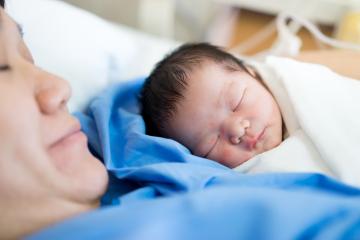
What recent findings from the Baby’s First Years study reveals about cash’s impact on family life of young children in the United States

As of 2023, nearly one in seven children are living in poverty in the United States. Despite this, we understand very little about the causal impact of poverty during a child’s earliest years. Experiencing poverty in early childhood is linked with a child’s subsequent learning, educational attainment, physical and mental health, and earnings into adulthood. The proposed ways in which poverty may influence children’s development is by affecting family time and money investments, relationships, parental stress, and parenting. Past work suggests that increasing family incomes will result in a large range of positive changes in family life. We sought to explore these hypotheses directly in our study, which examined the effects of providing financial resources to families starting at the birth of a child. So far, we have learned a lot about family life during the children’s early years.
The Baby’s First Years study is the first randomized control trial in the United States designed to estimate the impacts of an unconditional monthly cash transfer on family life and children’s development through early childhood. Starting in 2018, families with low incomes across four urban areas in the United States began receiving cash on a branded debit card “4MyBaby.” Mothers were recruited in hospitals and randomly assigned to receive either a “high cash” ($333) or a “low cash” ($20) gift amount. This allows our research team to compare outcomes across these two groups and attribute these differences directly to the difference in cash amounts. Because everyone had the same odds of getting the $333, any differences we find in outcomes are due to the differences in cash amount itself rather than differing group characteristics.
Mothers were free to spend the money in any way they wanted. Compared to other randomized studies of cash transfers, the Baby’s First Years study provided cash for a much longer duration—through the first six years of the child’s life. This represented about an 18 percent increase in financial resources given the low income of families at the time of birth. Nevertheless, it was relatively modest in the amount of monthly cash compared to some other studies (for example, the OpenResearch Unconditional Cash Study provided $1,000 per month for three years). The rationale for offering $333 per month in the Baby’s First Years study was twofold. First, the value of the cash gift was similar to what families might receive from existing government programs such as the earned income tax credit or food assistance. Second, research at the time suggested that this amount would improve children’s achievement.
In this study, we were particularly interested in understanding whether unconditional cash would change how households spend their time and money. For instance, does it improve family well-being by reducing parental stress, and improve the quality of their relationships?
We have learned some important insights on the ways that a modest monthly cash transfer affects family life as well as ways in which it does not. As expected, we found that the cash transfer reduced poverty and increased household income. We also found that the cash increased the time and money families spent on children. High cash gift families did not spend more on rent or groceries but they did spend more on things like books and toys for their children. There is no evidence that the cash was spent irresponsibly. The additional spending on child-specific items was estimated to be about $68 dollars a month.
While mothers in the high cash group also reported spending more time with their children in stimulating activities such as reading books or playing, we did not find an increase in the observed quality of the mothers’ interactions with their child. Mothers in the high cash group also reported similar levels of economic hardship and worry as mothers in the low cash gift group. Likewise, there were no group differences in self reports of well-being, psychological distress, and overall quality of their romantic or co-parenting relationships.
These mixed findings show that the cash went toward supporting families and children in some narrow ways, but did not have broad effects across other aspects of family life as originally expected. There are some things to keep in mind when thinking about how to interpret our study results.
First, even if it is true that $333 did not have broad effects on family life, the mothers welcomed the money, and spoke about it being meaningful to them. We know from qualitative interviews that this money was incredibly meaningful to recipients in many ways. One mother told us that when she got her first payment, she “put food in the house” and “got some cleaning supplies” to prepare her home for her new baby’s arrival. These seemingly small purchases can bring joy and relief to a mom doing her best just to get by, even if they do not result in differences in measures of parenting stress or mother’s mental health.
Second, it’s possible that $333 was not enough to overcome the key challenges facing families with low incomes. This may have been compounded by the fact that the amount of the cash gift did not change with family circumstances or the cost of living. It is also noteworthy that most families were receiving benefits from other government programs and continued to do so throughout the study. During the pandemic, we saw an expansion of these government programs and stimulus payments which resulted in many households having more income and other benefits than before the pandemic. Still, the extra cash may simply not have been enough to meet the high costs of child-rearing, including diapers, clothing, and child care, leaving families still struggling to make ends meet.
Third, even with $333 of additional income, families continue to face systemic barriers. These barriers include discrimination in the rental and employment markets, as well as violence in their communities. Unconditional cash transfers, while increasing family’s purchasing power, fail to address these bigger structural issues and that may in part explain the few impacts on family life.
Whether or not cash “works” and the ways in which it shapes families lives is unfortunately not something we can decisively answer with one study alone. Our study is ongoing, and we will learn more in the coming months and even years. The results from our study and other cash transfer studies, collectively, will help the field learn more about how unconditional cash affects families. This will include understanding how larger amounts of money affect families, how effects differ by community and family characteristics, and how it matters at various points in the life cycle. These questions are worth asking and answering.
Lisa and Katherine are part of the seven-member lead research team for the Baby’s First Years study and would like to recognize their collaborators for making this work possible.
Related Content

Strengthening randomized evaluations with qualitative research: Baby’s First Years mothers' experiences

Strengthening randomized evaluations with qualitative research: Baby’s First Years household measurement


